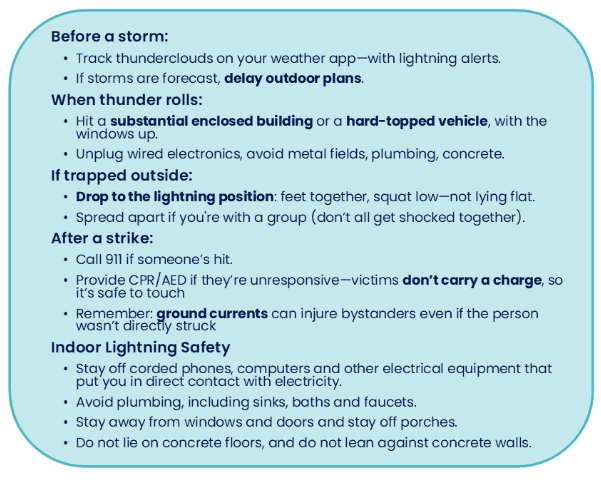
What to Do About the Shocking Surge of Lightning Strikes
(pun intended)
Lightning Strikes Are on the Rise — Literally and Alarmingly
So far this year, lightning strikes in the U.S. are well above normal, with multiple fatalities already reported before peak storm season has even wrapped. By mid-July, the U.S. had already recorded more lightning-related deaths than in all of 2024. And it’s not just bad luck — there’s science behind the spike.
As the planet warms, the atmosphere holds more moisture, and that extra moisture feeds stronger, more explosive storms. These souped-up storms generate more lightning. More heat, more water vapor, more vertical air motion — all the ingredients lightning loves. So yes, climate change is literally electrifying our skies.
And this isn’t limited to the usual “Lightning Alley” in Florida. One extreme example? In early July, the D.C.–Baltimore region experienced over 26,000 lightning strikes in one night — a staggering surge even by storm-prone Mid-Atlantic standards. Strikes are creeping into places and seasons where we didn’t used to worry much.
Extending the Safety Zone
Here’s something many people don’t know: you can be struck by lightning even when there’s no rain, and even when the sky above you is blue. These are called “bolts from the blue,” and they’re real. Lightning can travel 10 to 20 miles from the core of a storm — so just because you don’t see rain or hear thunder right away doesn’t mean you’re safe.
This is why we’re seeing an increase in lightning injuries among people who are doing totally normal things: fishing, hiking, golfing, working outside, or just sitting on a beach under what seems like a calm sky. The storm might look far off, but lightning has a much longer reach than most of us realize.
And it’s not just the direct hits that are dangerous. A nearby strike can cause ground current, where electricity radiates out through the ground, affecting people and animals standing nearby. Or side flashes, where lightning jumps from a tall object to a nearby person. So yes, you could be minding your own business under a tree, or next to a fence, and still end up on the wrong side of a thunderstorm.
What to Do — And What People Still Get Wrong
Despite decades of public service announcements and safety campaigns, there’s still a surprising amount of confusion about lightning safety. The good news? The core advice is simple and hasn’t really changed. But now it is much more important that we actually follow the rules.
When thunder roars, go indoors. And stay there for 30 minutes after the last thunderclap.
That last part is key and often ignored. Just because the storm sounds like it’s winding down doesn’t mean you’re in the clear. Lightning can still strike as the storm moves away. So, if you’re watching from your porch, give it a half hour before you head back out to grill, swim, or check on your tomato plants.
If you hear thunder, your best bet is to get to a fully enclosed building or a metal-topped vehicle. Picnic shelters, tents, golf carts, and trees are not safe options.
Once you’re inside, you’re safer — but not invincible. Lightning can travel through plumbing, electrical wiring, and even concrete walls and floors (thanks to the metal inside). So yes, it’s still true that you shouldn’t shower, bathe, wash dishes, or talk on a landline during a storm. This may sound like old wives’ tale advice, but it’s grounded in physics, not folklore.
What If You’re Caught Outside?
If you are caught outside with no safe shelter anywhere nearby, the following actions may reduce your risk:
- Immediately get off elevated areas such as hills, mountain ridges, or peaks
- Never lie flat on the ground
- Never shelter under an isolated tree
- Never use a cliff or rocky overhang for shelter
- Immediately get out and away from ponds, lakes, and other bodies of water
- Stay away from objects that conduct electricity (barbed wire fences, power lines, windmills, etc.)
And if you’re stuck, your last resort is the “lightning position”: squat low, heels together, arms wrapped around your legs, head down. It’s not a fashion-forward pose, but it reduces your height and limits how much of your body is in contact with the ground — both of which can make a difference if lightning strikes nearby.
If you’re with others, spread out. One lightning strike can injure multiple people if you’re huddled close together.
And if someone is struck? Call 911 immediately. Contrary to myth, lightning strike victims do not carry a charge — you can touch them safely. In fact, quick CPR or use of a defibrillator (AED) can save their life. Many survivors recover fully with fast emergency care.
The Bottom Line
Lightning needs to be top of mind during the summer — it’s when 60% of lightning strikes occur, and we’re often outside with phones in hand, metal gear nearby, or no plan if the sky turns dark. Lightning is increasing its reach year after year. It’s powerful, fast, and often unpredictable. The advice that previously may have seemed extreme has become essential. The simple rules are easy to remember and will save lives if we actually follow them. Feel free to clip and post the reminder below!
